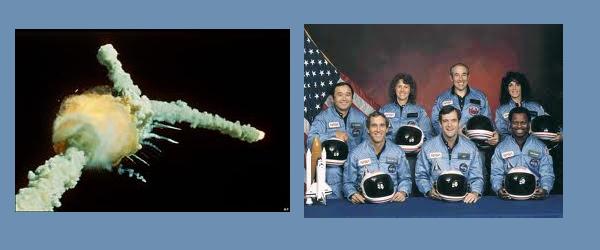I was 10 years old and in the fifth grade. We were in our classroom, waiting for the teacher to come in. She did eventually come in, crying; and that’s when a TV was brought into each classroom where we saw the aftermath of the Space Shuttle Challenger explosion. It was January 28th, 1986 and sadly, is our topic for today’s Flashback Friday.
The actual explosion occurred 73 seconds after liftoff, killing all seven crew members aboard. The shuttle virtually disintegrated into the Atlantic Ocean off the coast of central Florida at approximately 11:39 a.m. EST. It was later found that an O-ring seal in the right solid rocket booster failed at liftoff. This failure breached the joint it sealed, which allowed pressurized hot gas from the motor of the solid rocket to get to the outside and infringed on the functioning of other parts. Then there was a structural failure of that external tank which led to the explosion itself. It was later discovered that several crew members actually survived the initial breakup of the shuttle, but did not survive the impact of the crew compartment slamming into the ocean.
This disaster halted the space program for 32 months, and also prompted President Reagan to form what was called the Rogers Commission to investigate the tragedy. This commission later found that key elements of the decision making process and organizational “culture” that led to the explosion. Apparently NASA managers knew that the solid rocket booster designs had a potentially fatal flaw in the O-rings for at least 9 years prior to the explosion but didn’t address it properly. Another shocking discovery was that crew escape wasn’t possible either, at least during a powered flight. NASA had considered launch escape systems but decided that the shuttle’s expected high reliability didn’t necessitate one.
Many people actually saw the lift-off and tragedy itself due to the inclusion of teacher Christa McAuliffe in the crew, who would’ve been the first teacher in space. The other crew members who lost their lives that day were: Commander Francis (Dick) Scobee, 46, who was married with two children. Pilot Michael J. Smith, 40, was on what would have been his first space flight. Mission Specialist Judith A. Resnik, 35, had previously become the second American woman in orbit during the maiden Discovery flight. Mission specialist Ronald A. McNair was 35 at the time of his death, and was married with two children. He became the second Black American in space back in 1984 during a previous Challenger mission. Ellison S. Onizuka was the third mission specialist, he was 39 years old, married with two children. Payload specialist Gregory B. Jarvis was not an official federal employee, but rather employed by Aircraft Corp.’s Space and Communications Group in Los Angeles, California, who made it possible for him to be on the Challenger flight.
The final crew member on the flight was Sharon Crista McAuliffe, the first teacher to fly in space. She was selected from an applicant pool of around 11,000 education specialists. McAuliffe was 37 at the time of her death, married to her longtime boyfriend Steven. NASA’s intent of having her on board was to have a gifted teaching professional who could communicate with students from space.
Do you remember this event? Tell us about it in our forums here .


